Work Party Dates:
March 10th – 2 pm
April 14th – 2 pm
May 15th – 6 pm
June 13th – 6 pm
Updates:
Cetti’s Warbler photographs added to 30th January 2018.
Many thanks to Mike Hearn and John Hunt for their help in maintaining the blog for much of January.
Photographs added to the 6th, 7th and 11th.
Addition to the 12th February.
Addition to the 19th and 20th February
Photograph added for the 15th February 2018.
Additional records for the 27th added.
Additional records for the 28th added.
Recoveries:
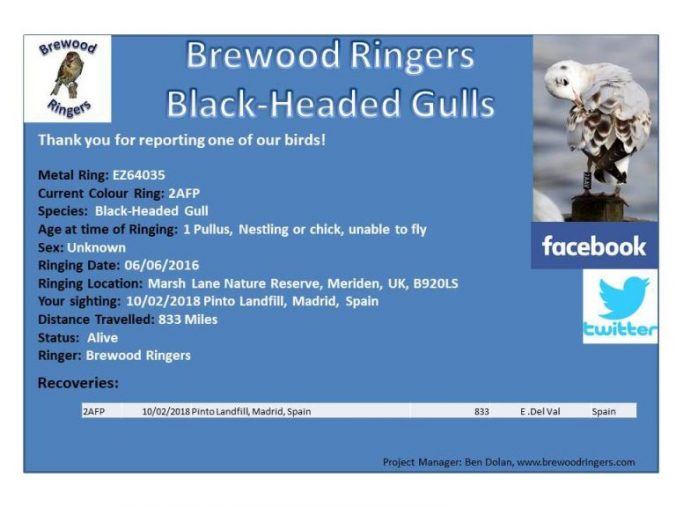
28th February 2018
Snow showers, cold north-easterly wind.
Most of the pools were iced up this morning as temperatures plummeted to minus 5.
The crop field was still busy with at least 70 Linnets, 20 Chaffinches and a Brambling and 15 Fieldfares and 20 Starlings flew into the Oaks by the car park before flying off west. There were at least eight Snipe in the rushes by the Oak Hide feeder and at least four Rooks went over.
Later in the morning at least five Curlew put in an appearance which I believe is a record number at any one time. There were also two Oystercatchers and a Peregrine.
27th February 2018
Some cloud, sunny intervals, light, cold north-easterly wind, minus 2 degrees.
The main pools remain largely ice free because of the wind, though there was some ice on the margins. However, the pond by the Car Park Pool was completely frozen over. The Linnet flock had increased to at least 90 this morning commuting between the crop field Oaks and the car park. Also in the crop field Oaks were at least 20 Chaffinches, three Bramblings (one male and two female) and two Yellowhammers. Four Rooks went over to the west at 8.15 and possibly two of those came back again shortly after.
A Collared Dove also flew low to the north.
As the morning developed, five Oystercatchers appeared on the various islands, 20 Snipe emerged from the rushes to the rear of Oak Hide, there were two Shelduck and a total of five Bramblings at the feeders. There was also a Little Egret and the regular adult Great Black-backed Gull.
26th February 2018
Cold, north-easterly wind, sunny.
A male and two female Goosanders were present on Car Park Pool this morning, there were eight Snipe in front of Oak Hide, two Yellowhammers at the car park feeder and a male Sparrowhawk put in a brief appearance over Railway Pool and, in the process, flushing a number of birds.
25th February 2018
Cold north-easterly wind, sunny.
Not a great deal of change on the birding front today. There were six Oystercatchers on site together with four Goosanders (two pairs), 30 Snipe in the Marsh, two Shelduck, a Cetti’s Warbler along the causeway, a Water Rail in front of River Hide, 40 Fieldfares on the tip field, at least three Bramblings in the crop field and at least three Buzzards over Siden Hill Wood. Lastly a Skylark went over, possibly a bird moving from territory back to a feeding area and with the forecasted cold weather, there could other cold weather movements observable.
24th February 2018
Cold north-easterly wind, sunny.
Today’s highlight was another of the sporadic visits of a Great White Egret which flew south of Railway Pool at 11.15 but did not linger. There were still at least three female Bramblings in the crop field with 20 Linnets and other counts today were as follows: six Mute Swans, 79 Greylags, 18 Canadas, three Shelduck, 260 Wigeon, 12 Gadwall, 87 Teal, five Mallard, 17 Shoveler, eight Pochard, 40 Tufteds, two Little Grebes, 44 Cormorants, one Little Egret, 15 Moorhen, 55 Coot, 191 Lapwing, two Oystercatchers, 28 Snipe, 214 Black-headed Gulls, two Common Gulls, seven Lesser Black-backed Gulls and two Herring Gulls.
Lastly, two Yellowhammers joined the throng of other birds at the car park feeder.
23rd February 2018
Cold and sunny.
No records.
22nd February 2018
Overcast start, sunny pm, light easterly wind.
A pair of Goosanders roosted again on Car Park Pool where there were also two Shelduck and two Oystercatchers, plus a Little Egret. There were again at least seven Bramblings in the crop field.
21st February 2018
Mostly overcast, some sunny intervals towards the end of the day, light east, north-easterly wind.
The only record in the log was a pair of Goldcrest with no location given.
A ringed Mediterranean Gull (PPE4) seen originally on Railway Pool, then moved to Car Park Pool where it had a good wash and brush-up before flying in a southerly direction at midday.
It was ringed on the 19th May 2013 as a nestling at Nysa Reservoir in southern western Poland. This is about 70km south of Wroclaw. Prior to the sighting at Marsh Lane on the 21st February, it has also been seen as follows:
5th March 2016 Seen at Swidnica in south western Poland. This is about 45km south west of Wroclaw.
24th February 2017 Seem at Brouwersdam on the Netherlands coast. This is about 40km south west of Rotterdam.
23rd May 2017 Seen at Šenov in eastern Czech Republic. This is about 10km south east of Ostrava.
So, a well travelled bird !
Ringed Mediterranean Gull (PPE40) – Photographs by Max Silverman
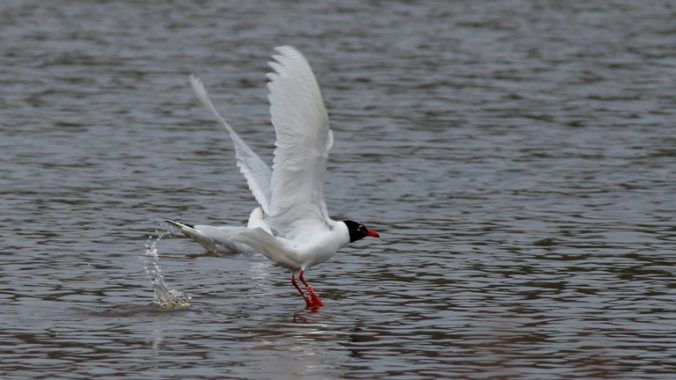
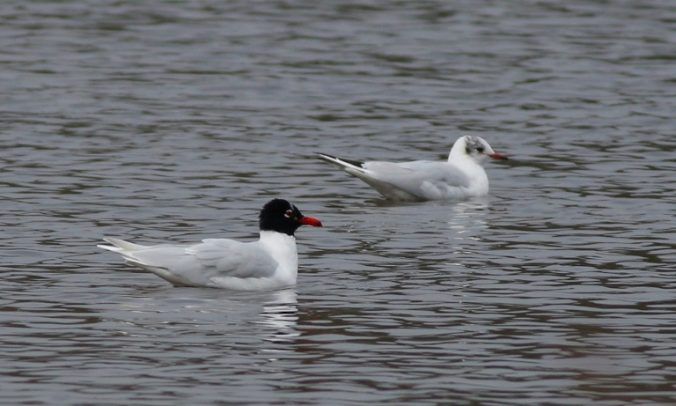
Photograph by Jeff Rankin

20th February 2018
Mostly sunny, cool northerly wind
I have had reported to me, helpfully that the first Ringed Plover of the year was visible on Railway Pool from Oak Hide this afternoon. Other records to follow.
Other birds today included four female and three drake Goosanders, a Little Egret, four Oystercatchers, the adult Greater Black-backed Gull, at least two, probably three Bramblings, 12 Pochard, two Little Grebes and one Great Crested Grebe.
19th February 2018
Drizzly.
A record count of 14 Pintail were this morning’s highlight, on Car Park Pool and they remained for much of the day. There were also a pair of Shelduck and a pair of Great Crested Grebes.
There were also 22 Snipe today, mostly in the Marsh, three female and a male Brambling with a Yellowhammer in the crop field and, once again, the car park feeder was busy with, amongst others, 13 Reed Buntings, four Goldfinches and four Greenfinches.
In the late morning a pair of Goosanders same in to Car Park Pool to roost and the Cetti’s Warbler was vocal by the north causeway hides.
Lastly, Bees were already active around the tree hole near the car park.
18th February 2018
Overcast start, clearing slowly, drizzly and overcast later in the afternoon.
The Ruddy Shelduck appeared again this morning and there were two pairs of Goosanders along with the adult Greater Black-backed Gull. A flock of 45 Siskins were feeding in the Alders on the central streamline and, in the crop field, there were seven Bramblings, 25 Linnets and two Yellowhammers.
Six Oystercatchers were challenging for territory in the afternoon and, as viewed out of the back gate, there were seven Goldcrest, two Lesser Redpolls, six Siskins and a Coal Tit in the Leylandii trees.
A Water Rail called in front of River Hide on Railway Pool.
17th February 2018
Overcast start, clearing slowly, sunny pm.
Another variation in Duck numbers saw a fall in Wigeon and Teal to 207 and 98 respectively, but there was a small increase in Tufted Duck numbers to 35. There were five Goosanders on site and the first Great Crested Grebes of the spring as well.
Main counts today were seven Mute Swans, 83 Greylags, 25 Canadas, a Greylag / Canada hybrid, one Shelduck, 207 Wigeon, 98 Teal, 26 Gadwall, 16 Mallard, 40 Shoveler, 11 Pochard, 25 Tufted, 45 Cormorants, a pair of Great Crested Grebes, one Dabchick, one Heron, one Little Egret, 17 Moorhen, 59 Coot, 326 Lapwing, 24 Snipe, four Oystercatchers, 300 Black-headed Gulls, two Common Gulls, two Lesser Black-backed Gulls, one Herring Gull, the adult Greater Black-backed Gull, a Cetti’s Warbler in the Reedbed, two Skylarks over, at least six Bramblings in the crop field along with three Yellowhammers and 34 Linnets and, finally, on the flood plain there were 50 Fieldfares, two Redwings and two Mistle Thrushes.
Later in the afternoon there were four to six Goldcrests at the rear of Railway Hide and 15 Great Crested Grebes were noted at Bradnocks Marsh.
16th February 2018
Sunny.
There was an impressive count of 12 Goosanders today along with three Oystercatchers and 42 Cormorants. A pair of Bramblings joined the small Chaffinch flock in the crop field and a Treecreeper and a Muntjac were recorded, although no locations were given.
15th February 2018
Mostly fine and sunny with occasional wintery showers
The adult Greater Black-backed Gull was on site along with two male and three female Goosanders, up to four Oystercatchers and two Shelduck.
Photograph by Jeff Rankin – 15th February 2018
Yellowhammer, Little Egret, Brambling and Kestrel
(Yellowhammer, Brambling and Kestrel on the Crop Field and Little Egret feeding in the Marsh, late morning)
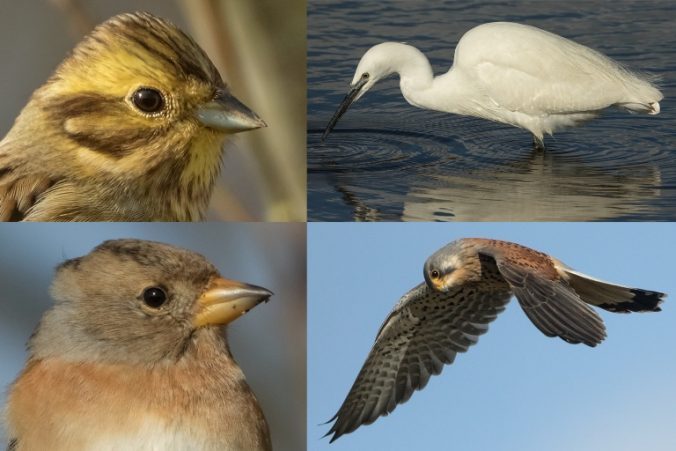
14th February 2018
Wet and miserable all day.
The inclement weather and Valentines Day obviously precluded any visits and there were no records.
13th February 2018
There were two Greater Black-backs on site today, an adult and a first-winter along with two Oystercatchers, 25 Snipe, five Bramblings (two males and three females) and five Yellowhammers.
12 February 2018
Mostly sunny, with ice.
Both the male Ruddy Shelduck and the Egyptian Goose were on site today occasionally leaving to feed either along the river or along the flood plains. There was a single drake plus three female Goosanders along with two Shelduck, 36 Snipe, 42 Cormorant and two female Bramblings in the crop field.
The adult Greater Black-backed Gull was again on site and 60 Starlings were feeding on the islands. The light icing saw Water Rail wander out onto it in the north causeway bay.
Brambling numbers increased with two males and three or four females, three Yellowhammers and up to 40 Linnets. A second male Goosander appeared on site and an unquantified number of Fieldfares were feeding on the flood plain.
11th February 2018
Sunny intervals with wintery showers, cold north-westerly wind.
Today’s surprising arrival was a Ruddy Shelduck which ended up consorting with the Egyptian Goose in various places including on the flood plain. By dusk, the bird could no longer be seen but might have gone onto the river and could still be on site.
Egyptian Goose and Ruddy Shelduck – photograph by Jeff Rankin
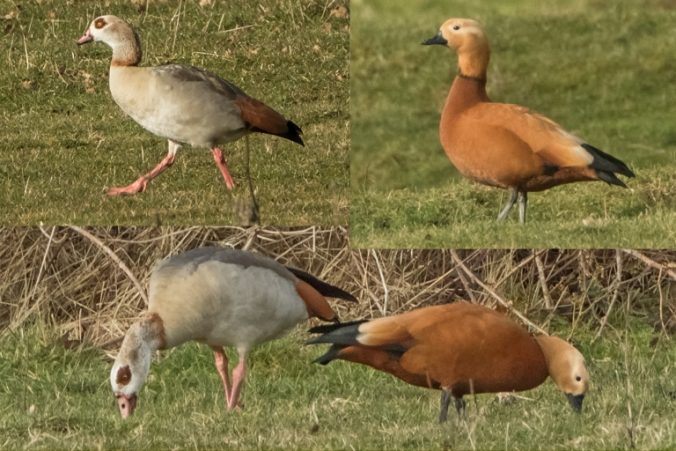
There was also a significant arrival of Black-headed Gulls with at least 820 counted on Railway Pool in the early afternoon and there were also four Shelduck on site. A Jack Snipe was seen in the wet field by the mobile phone mast, a Cetti’s Warbler was in song around the causeway bay, there were at least five Bramblings (two males and three females) in the crop field with the Chaffinch flock and, at dusk, seven Goosanders arrived to roost on Car Park Pool (two males and five females).
Also at dusk there was a gathering of at least 400 mixed Corvids on the ice rink field (east side of Siden Hill Wood) but they were both so closely packed together and the light was sufficiently poor for an adequate split of the species to be too difficult.
10th February 2018
Wet am., easing pm., cold north-westerly wind.
The balance of the Duck numbers again changed with Wigeon up from last week’s count of 208 to 320 this morning but Teal numbers had fallen from last week’s 152 down to 113. Mallard are becoming increasingly scarce as birds depart to smaller pools for breeding purposes and the spring arrival of Tufteds is to commence.
Full counts of wildfowl are shown below. In addition, the adult Greater Black-backed Gull appeared for its usual preen and roost on the Car Park Pool islands, there were at least five Bramblings in the crop field, along with two Yellowhammers and a Treecreeper showed particularly well along the central streamline.
Other counts were as follows: seven Mute Swans, 13 Greylags, three Shelduck, 33 Gadwall, 14 Shoveler, eight Pochard, 21 Tufted, 27 Cormorants, one Little Grebe, two Herons, one Little Egret, 32 Moorhen, 72 Coot, 135 Lapwings, one Oystercatcher, 23 Snipe, 310 Black-headed Gulls, five Common Gulls, seven Lesser Black-backed Gulls and two Herring Gulls.
A Muntjac also showed itself along the central streamline towards the lorry park.
Fortunately the rain eased for the afternoon work party when eight carried out the usual miscellany of tasks. Mice in the feed store entailed some rearrangement of bird seed etc., whilst a concerted effort by the majority saw the thinning out of the regenerating Alders in the north causeway bay. Nest boxes on the east side were also cleared out and the car park bird feeders were tidied up. Thank you to all those who attended.
9th February 2018
Sunshine and showers, early dawn, south-westerly wind.
Despite a change in the wind direction it was still cold this morning and the crop field Oaks were busy with Finches. There were at least 40 Linnets, 20 Chaffinches and seven Bramblings and the balance of males and females has changed again with at least five males this morning. There were also 14 Pheasants in the crop field. A Little Egret must have roosted overnight as it departed at dawn and likewise an Oystercatcher was on Car Park Pool and that also flew off to the south-west. Nine Rooks went over at dawn, there were six Greenfinches on the car park feeder, a singing Song Thrush by Oak Hide and an un-singing bird along the causeway.
8th February 2018
Sunny am, clouding over pm, heavy rain overnight.
Today’s records included five Goosanders (two drakes and three females), the Egyptian Goose, an Oystercatcher on Car Park Pool from 10 am until 12.50, a Goldcrest by Railway Hide and a reasonable number of large Gulls, including eight Herrings, 20 Lesser Black-backs and the Greater Black-backed Gull. There was also a Little Egret.
7 February 2018
Cold, temperatures below freezing, light ice around the pool margins. Sunny.
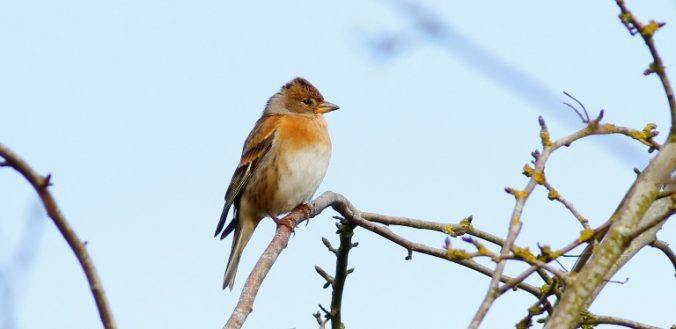
Brambling – Photograph by Max Silverman
Initially, of interest, was a drake Shelduck on Car Park Pool but the Egyptian Goose arrived during the middle of the morning and there were at least three Bramblings in the crop field.
Warring Goosanders (Car Park Pool) – Photograph by Jeff Rankin
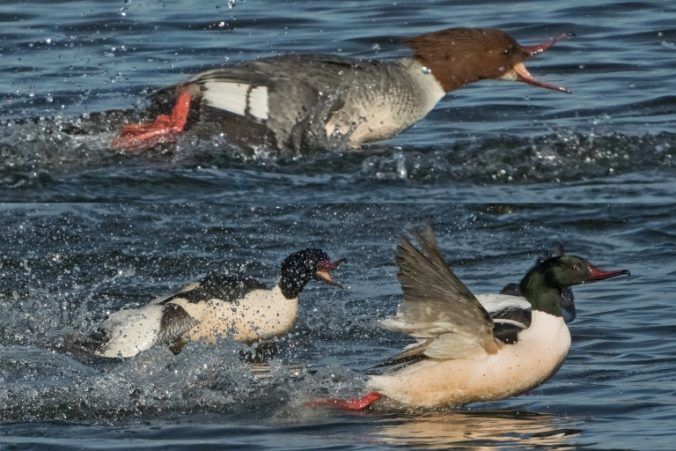
6th February 2018
Sunny am, slowly clouding over pm with wintery showers, cold east, north-easterly wind.
A good mix of birds today included one Egyptian Goose, two Shelduck, four Goosanders, the adult Greater Black-backed Gull, 18 Snipe, two Little Egrets and, in the crop field, at least three Bramblings joined 20 Chaffinches, 40 Linnets and three Yellowhammers.
In the late afternoon, five Whooper Swans flew over, flying west.
Whooper Swans – 6th February 2018 – Photograph by Chris Fent
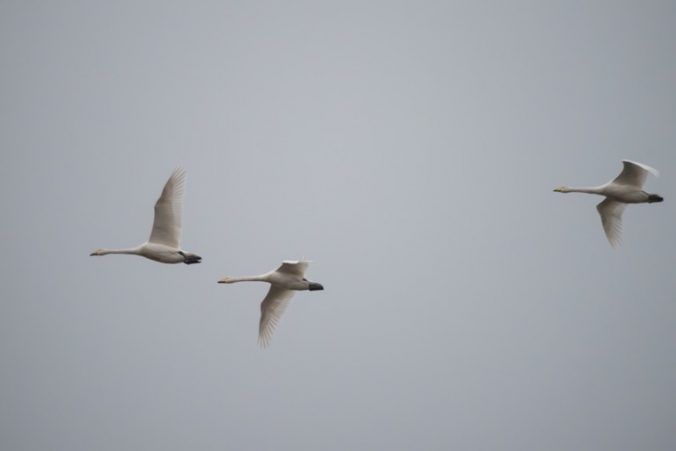
5th February 2018
Mostly sunny, cold north easterly wind.
The Great White Egret put in one of its sporadic appearances this morning, joining a Little Egret on Railway Pool.
A male and female Brambling were feeding with a dozen Chaffinches in the crop field and, later, the male visited the car park feeder to join a pair of Yellowhammers, 14 Starlings and six Reed Buntings (amongst other birds).
11 Snipe were visible in the Marsh but Mute Swan numbers had dropped to 12.
4th February 2018
Mostly sunny. Light north-easterly wind.
An Egyptian Goose was a somewhat surprising find on Car Park Pool this morning at around 10 am, before moving to the river and then, a little later, appearing with the Greylags also on Car Park Pool.
At about 2.30 pm a pair of Pintail appeared very briefly on Car Park Pool, but did not linger and were replaced by three female Goosanders.
Other birds of note today included the adult Greater Black-backed Gull, 297 Lapwings, a displaying Raven over, 27 Snipe in the Marsh, 20 Starlings feeding on the Car Park Pool islands, at least three Little Egrets on site, 27 Shoveler, and 11 Pochard.
Finally, there were at least six Bramblings in the crop field in the afternoon, none of which had been present in the morning.
3rd February 2018
Mostly wet.
In the crop field this morning there were still at least six Bramblings at least the two bright males and also a small Linnet flock of 20 birds. There was just a single Yellowhammer. On the flood plain there was a flock of Thrushes comprising at least 100 Fieldfare, 50 Redwing and a single Mistle Thrush.
On the pools or islands, there were three Greater Black-back Gulls this morning, two adults and a third winter and an impressive count of 58 Snipe (40 in the Marsh, 16 on Car Park Pool and two on Dragonfly Pond).
Other counts today comprised 11 Mute Swans, 19 Greylags, 280 Wigeon, 30 Gadwall, 152 Teal, 17 Mallard, 12 Shoveler, six Pochard, 21 Tufted, one Shelduck, 44 Cormorants, two Herons, two Little Egrets, one Little Grebe, 24 Moorhen, 65 Coot, 275 Lapwing, 140 Black-headed Gulls, two Common Gulls, four Lesser Black-backed Gulls and three Herring Gulls.
2nd February 2018
Mostly fine.
The Great White Egret appeared again, arriving at 4.15 and spending about 15 minutes on Car Park Pool before disappearing.
A reasonable supporting cast, including two Greater Black-backed Gulls, a pair of Goosanders, a Shelduck, four Little Egrets and at least six Bramblings. Two of the latter are fine males beginning to come into good plumage.
Other birds recorded in the log included 31 Cormorants, 180 Lapwings, five Stock Doves, one Little Grebe and seven Snipe.
1st February 2018
Cold start, cloudy with showers, clearing later. Keen NW breeze.
The recent run of Great White Egret records has continued into February, with an individual present on Car Park Pool from 08:00 until at least midday, this being the ninth for the Reserve and the fourth since the start of the year.
Other logbook entries for the pools included six Goosander (3M+3F), the Greater Black–backed Gull, Little Egret and 18 Snipe. Mute Swan numbers have continued at an exceptionally high level, having now increased to 56. From a very quick scan of recent annual reports and subject to confirmation, this looks to be the highest count of the past few years and possibly even a site record.
Elsewhere, the Crop Field was busy with four Brambling (2M+2F), 20 Chaffinch and 10 Linnet. There was also a mixed group of 40+ Fieldfares and Redwings along the Old Road.
